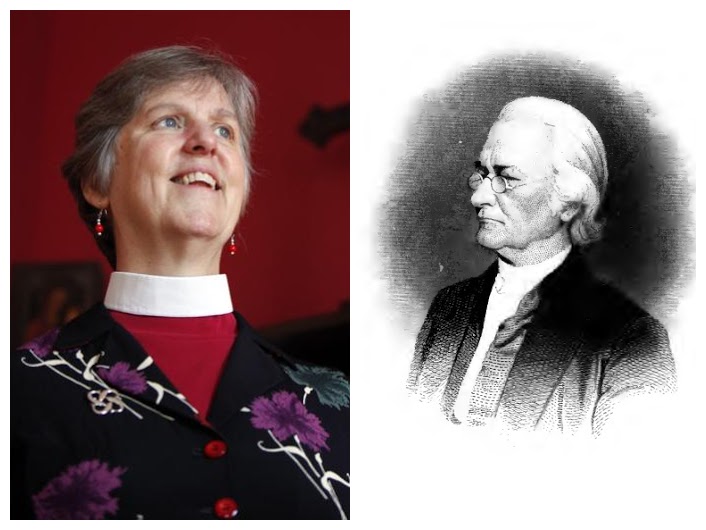The Rt. Rev. Susan E. Goff, Bishop Suffragan and Ecclesiastical Authority, Diocese of Virginia, supports the removal of the Lee monument on Monument Avenue in Richmond, Virginia. Diocesan House is located in the city of Richmond, once the capital of the Confederate States of America.
Her statement is provided below, but first consider the words of Bishop William Meade, third bishop of the diocese, to Lee about Lee. Gettysburg College historian Allen Guelzo writes:
The aged Episcopal bishop of Virginia, William Meade, gave Robert E. Lee his dying blessing: “You are engaged in a holy cause.”
I see it now as I have never seen it before. You are at the head of a mighty army, to which millions look with untold anxiety and hope. You are a Christian soldier—God thus far owns and blesses you in your efforts for the cause of the South. Trust in God, Gen. Lee, with all your heart,” and placing his palsied hands on the General’s head, he added in a voice never to be forgotten by the bystanders, “you will never be overcome—you can never be overcome.”
Holy causes that can never be overcome do not make provision for surrender.
Bishop Goff’s statement:
Support for Removal of R. E. Lee Memorial
The Power of Symbols:
Support for the Removal of the Robert E. Lee Monument in Richmond
Symbols are powerful. We learn early in our lives that particular shapes, colors, words or images are imbued with meaning far beyond what mere appearance would suggest. We see an eight sided red sign at an intersection while we are driving, and we stop. We find our way to the restroom, to a staircase, or to an exit by following simple shapes and drawings. When we travel in a cultural context different from our own, it may take a bit of time to learn to “read” the new symbols, but eventually we make our way.
There are powerful symbols in the city of Richmond and in cities and towns across our Diocese that were erected to convey a message as clear and unambiguous as stop signs. According to a Statement on Confederate Monuments written by the American Historical Association after the violence in Charlottesville in August of 2017, “The bulk of the monument building took place not in the immediate aftermath of the Civil War but from the close of the 19th century into the second decade of the 20th. . . [T]his enterprise was part and parcel of the initiation of legally mandated segregation and widespread disenfranchisement across the South. Memorials to the Confederacy were intended, in part, . . .to intimidate African Americans politically and isolate them from the mainstream of public life.”
For decades, these monuments have sent a message that the lives and experiences of black persons are not valid or valued. As such, they have done harm not only to black Americans, but to all Americans, because whatever harms any member of our community harms us all. Symbols erected with the purpose of dividing citizens one from another are antithetical to the teachings of our Lord who said, “Love your neighbor as yourself.” Removal of such monuments, including the Robert E. Lee statue in Richmond, conveys the faith that God loves everyone, everyone, everyone without exception. It is consistent with the vows we make in our Baptismal Covenant when we promise “to seek and serve Christ in all persons, loving our neighbor as ourself” and “to work for justice and peace among all people, and respect the dignity of every human being.”
The removal of the Robert E. Lee moment is also consistent with the writings of Lee himself. In response to a proposal in 1866, he wrote, “As regards the erection of such a monument as is contemplated, my conviction is, that however grateful it would be to the feelings of the South, the attempt in the present condition of the Country, would have the effect of retarding, instead of accelerating its accomplishment; [and] of continuing, if not adding to, the difficulties under which the Southern people labour.” When asked about the erection of a memorial at Gettysburg in 1869, Lee wrote, “I think it wiser…not to keep open the sores of war but to follow the examples of those nations who endeavored to obliterate the marks of civil strife, to commit to oblivion the feelings engendered.”
Even as the Robert E. Lee statue on Monument Avenue in Richmond is removed, it will remain a piece of our history. Its story will appropriately be told in a wider historical context that will include the peaceful demonstrations that have happened at its base in recent days. The removal itself will be included in the wider story. I pray that the full history, past, present and future, will become a part of truth-telling that leads us to recognize a greater measure of God’s peace and God’s hope in our world.
Symbols are powerful. Which symbols will we claim and hold high as signs of our faith and life in Christ? Which symbols will we remove for the sake of others? What new symbols will emerge as we walk Jesus’ Way of Love?
Faithfully yours,

The Rt. Rev. Susan E. Goff
Bishop Suffragan and Ecclesiastical Authority
Episcopal Diocese of Virginia
#end#
Bishop Meade prior to the onset of the Civil War:

